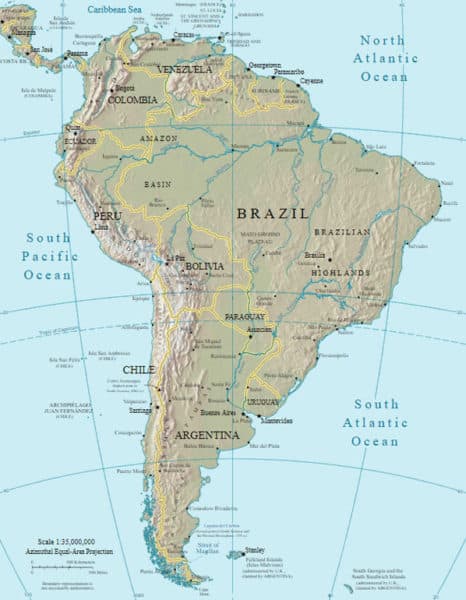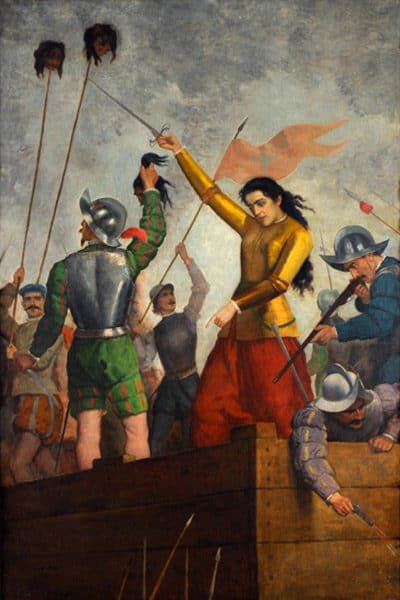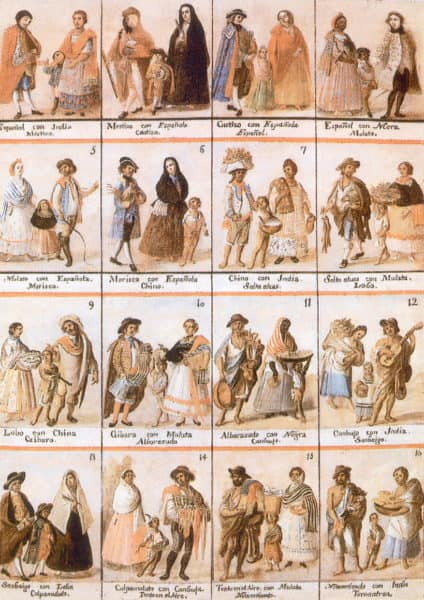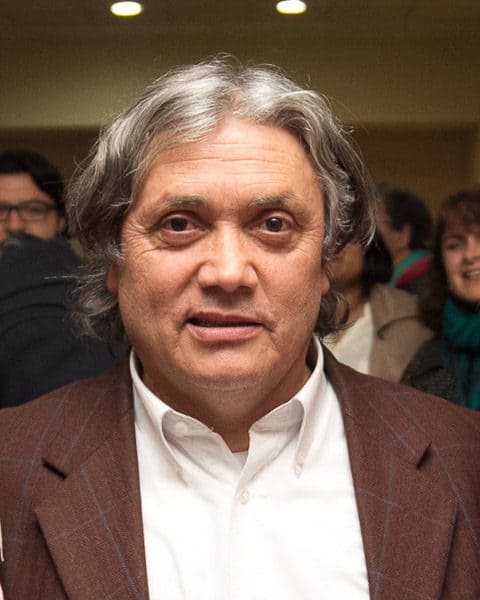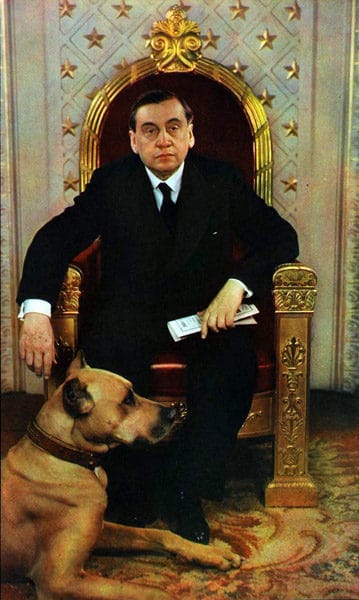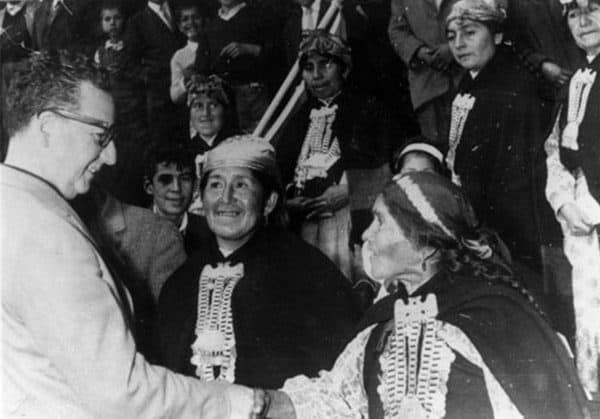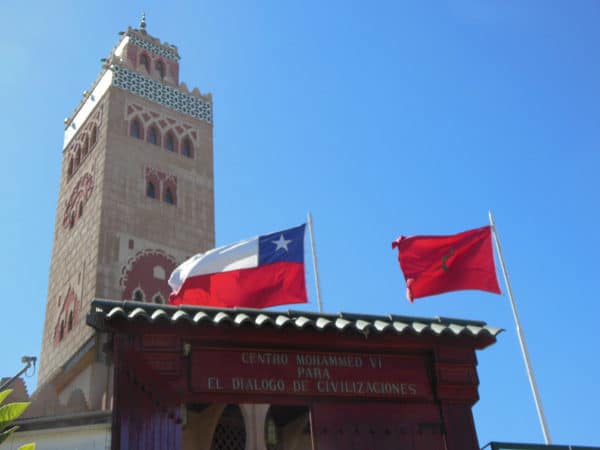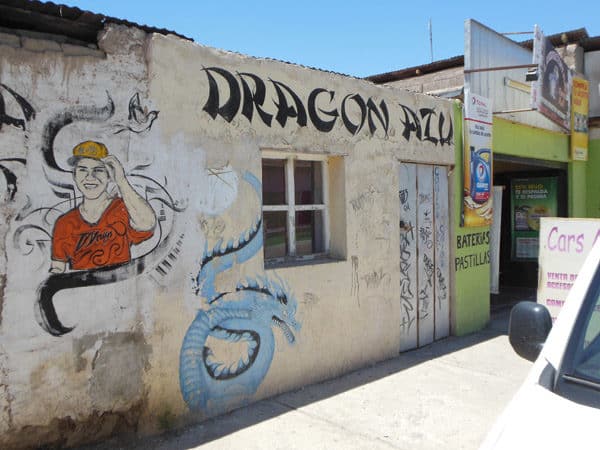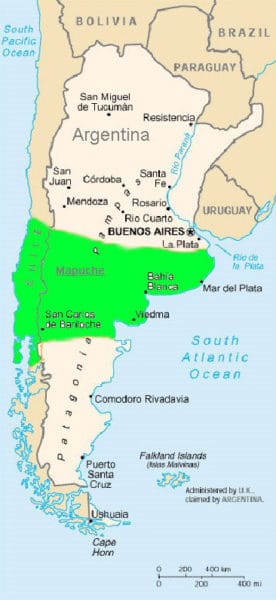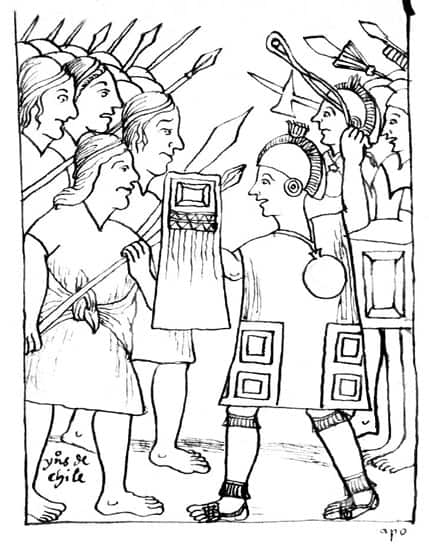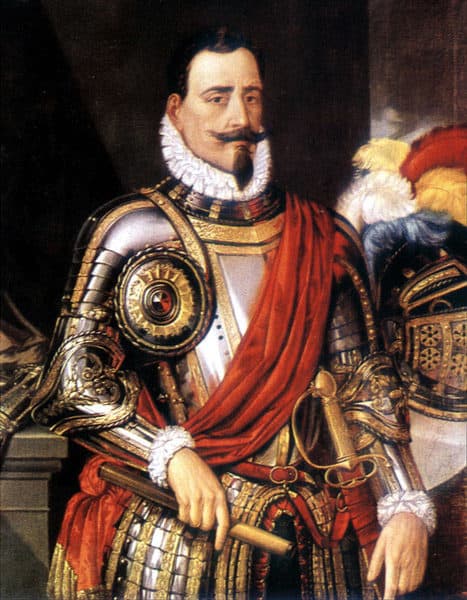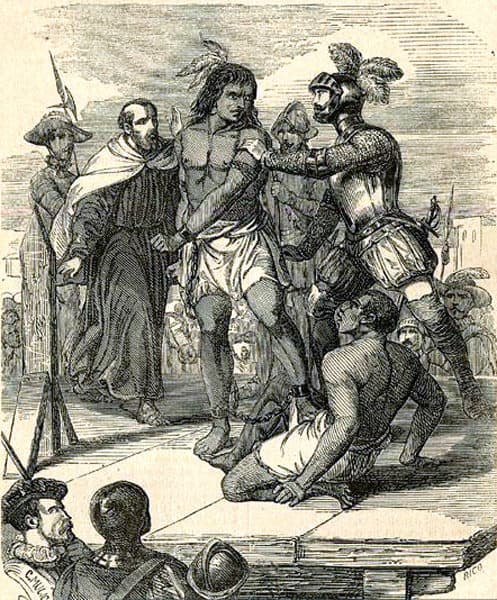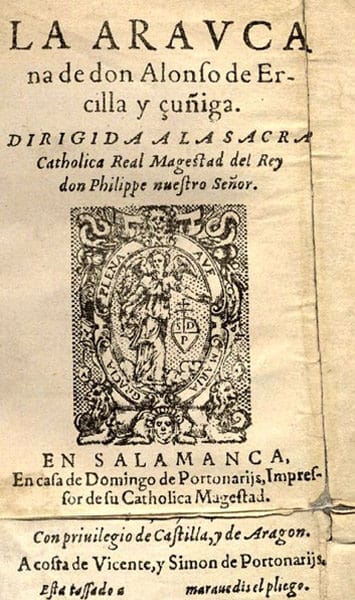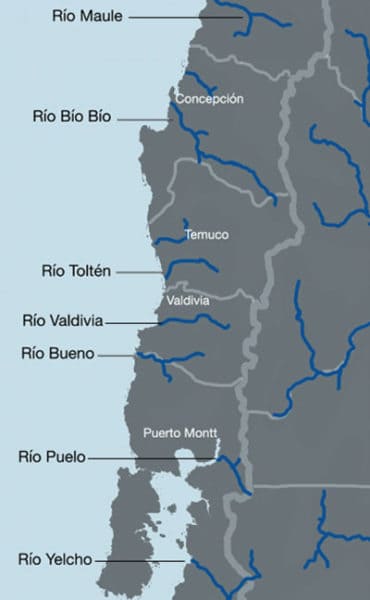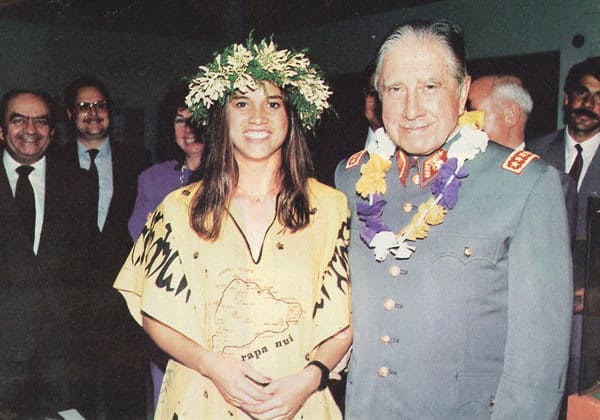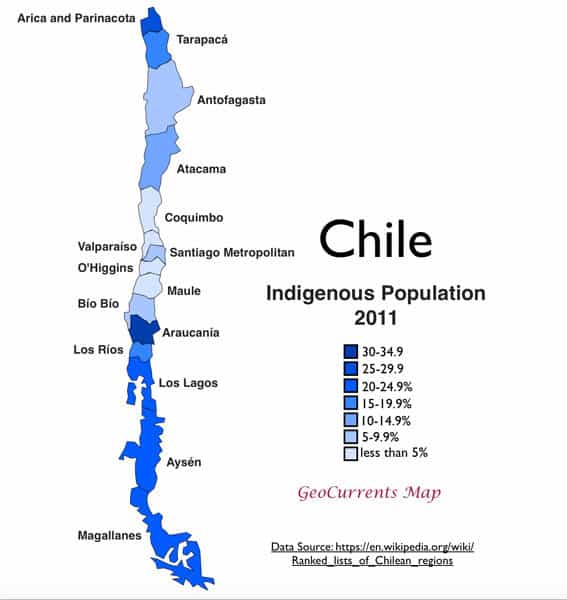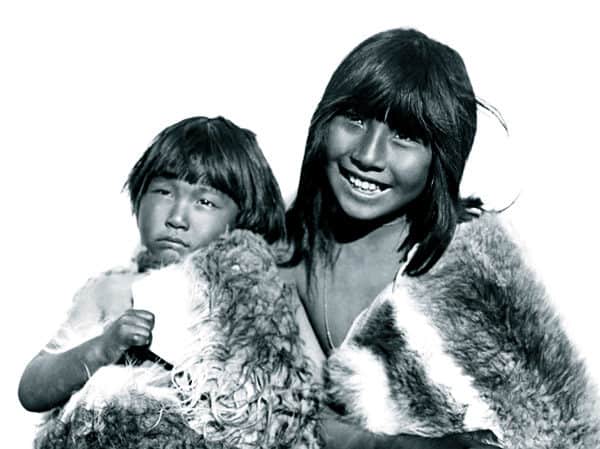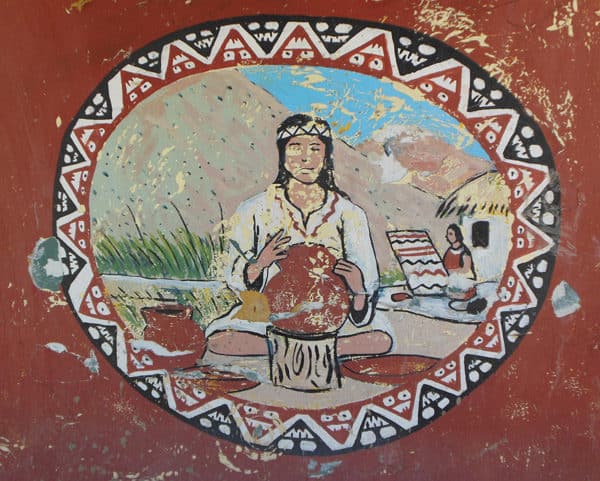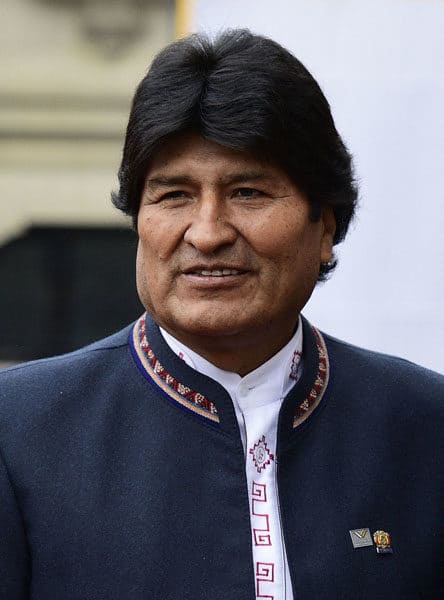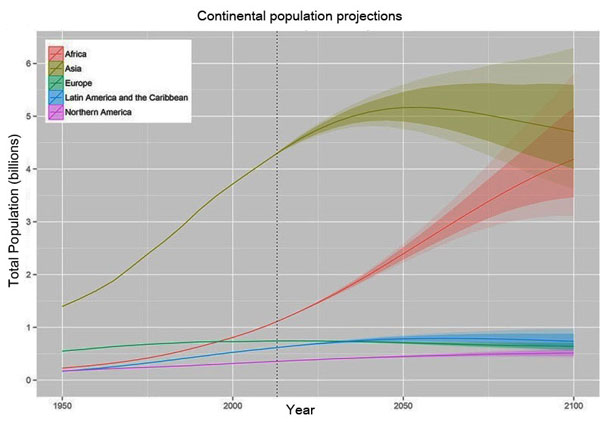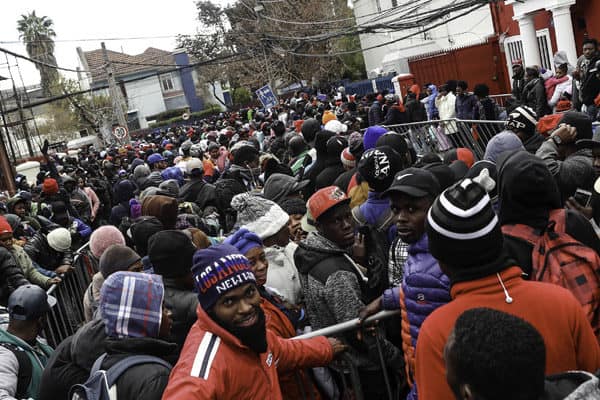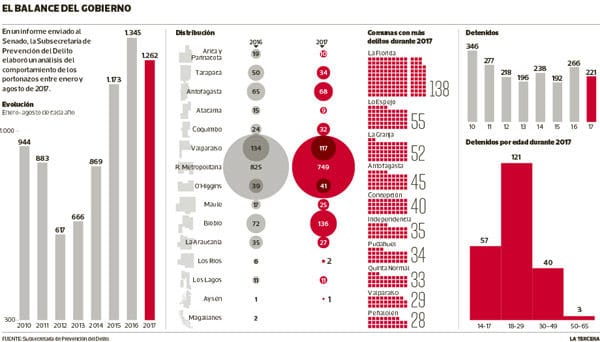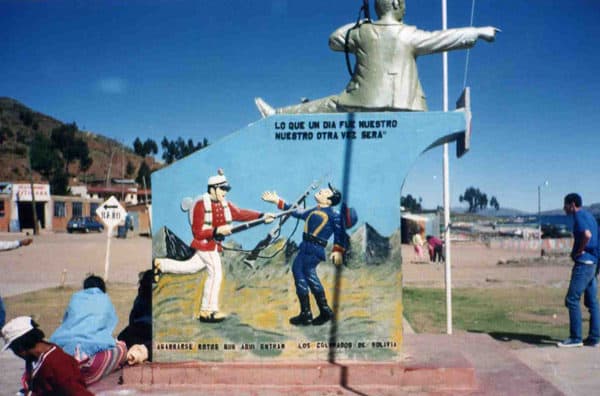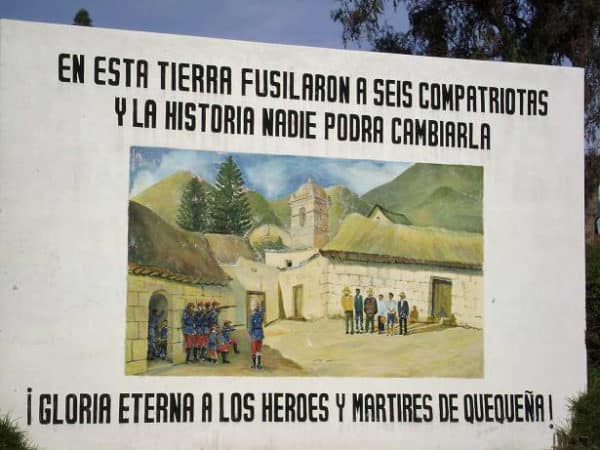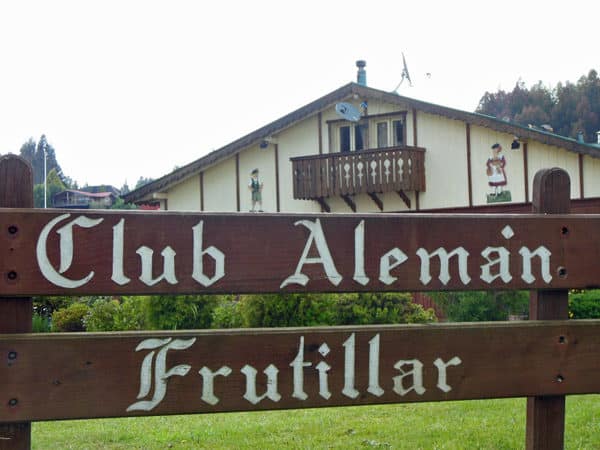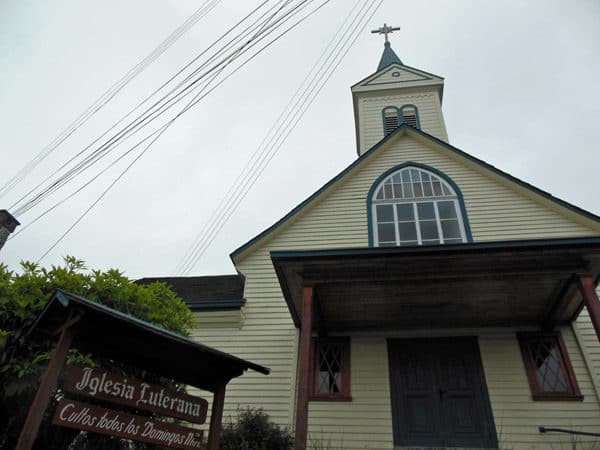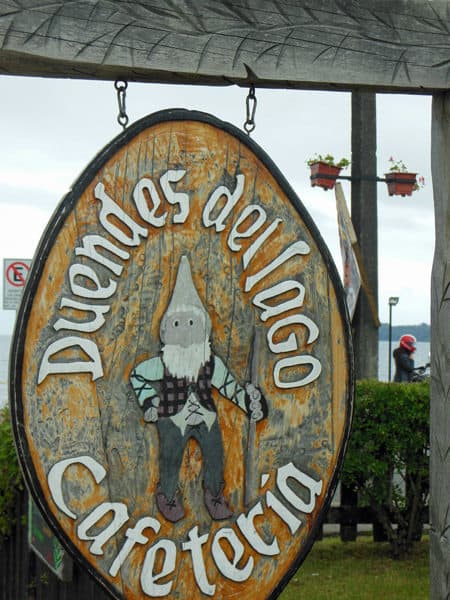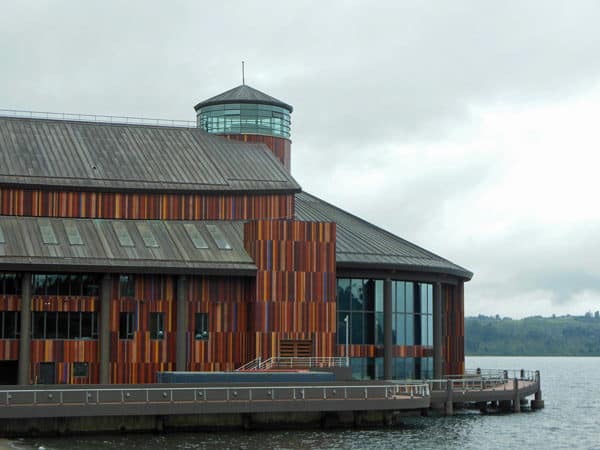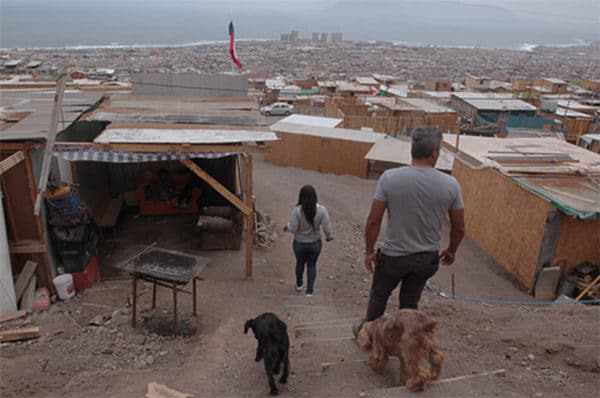Much like whites in Europe and the Anglosphere, the whites of the small Latin American nation of Chile face a demographic crisis that stems from unchecked immigration and low birth rates. Chile has a distinctive history, society, and culture little known or appreciated in the English-speaking world, but it has arrived — in its own, unique way — at the same racial crossroads as such nations as Britain, France, and the United States. It’s a fascinating story, well worth telling, and underscores the global nature of our susceptibility to dispossession.
A regional powerhouse
There are three factors that set Chile apart from the rest of Latin America. (For the purposes of this essay, “Latin American” means every nation in the Western Hemisphere aside from the United States and Canada, including Caribbean islands.) Those three are: democratic institutions, economic power, and military prowess.
Chile’s democratic tradition, while less robust than that of Britain or the US, is much stronger than any of its neighbors. Aside from Augusto Pinochet’s military regime from 1973 until 1990, and Carlos Ibáñez del Campo’s first government, from 1927 until 1931, Chile has never had a dictatorship lasting more than a year — and its two twentieth century autocrats, it should be noted, are among the most benign in Latin American history. Many other nations in South America are dizzyingly volatile. Between 1900 and 2000, Peru had 31 different heads of state, averaging a change in leader about once every three years. During the same period, Bolivia had 45 different heads of state — averaging a new one almost every two years.
Chile’s relative absence of corruption is also a testament to the strength of its institutions. When the world’s countries are ranked from least to most corrupt (meaning number one is the least corrupt), Chile is number 24, meaning it is less corrupt than several European countries, such as Spain, Portugal, and Poland. Very few other Latin American nations even come close to this ranking: Brazil is 79, Argentina is 95, Bolivia is 113, and Mexico is 123. Similarly, Chile is considered to be one of only three South American nations with complete freedom of the press — the other two are Uruguay and Suriname.
Chile’s Gross Domestic Product (GDP) per capita is the highest on the continent, and over three times that of its neighbor Bolivia, and nearly double that of its neighbor Peru. There are other indicators of Chile’s prosperity as well. In Chile, 55 percent of the population has a credit card. In Brazil, it is 30 percent, in Mexico 25 percent, and Peru just 20 percent. For every 1,000 Chilean citizens, there are 230 automobiles. In Peru it is 73, and in Bolivia it is just 70. Per capita, Chile has more smartphones than any other nation in Latin America — and more even than China or Russia. I have spent plenty of time in Chile, and while it is appreciably poorer than the US and Western Europe, its economy is quite modern. In the capital city of Santiago, you can buy Red Bull, take an Uber to a rock concert, go shopping at American and European clothing retailers, and so on.
Chile’s military history is equally impressive. In the 19th century, Chile decisively defeated its two northern neighbors Bolivia and Peru in what is known as the “War of the Pacific.” Chile gained vast swathes of resource-rich land from this conflict, and left Bolivia permanently landlocked. In the same century, Chile finally and decisively defeated the hostile Amerindian nation to their south, the Araucanos (who are sometimes referred to as “Mapuches”), after fighting them on-and-off for centuries. Just as the War of the Pacific has many parallels to America’s war with Mexico, Chile’s southward territorial expansion at the expense of the Amerindians has many parallels to America’s westward expansion. Chile has had two (arguably three) very small civilwars, each lasting a year or less, with minimal bloodshed. Just as Chileans have no historical understanding of what it is like to live under a harsh autocratic regime such as that of Fidel Castro, they have no historical understanding of the sort of catastrophic total civil war that America experienced in the 1860s, or that engulfed much of Central America throughout the 1980s. Chile has never lost a war, and today its technologically advanced, well equipped, and well trained military is feared and envied by its neighbors.
Spanish conquistadores defend the recently founded city of Santiago against Araucanos in the mid-sixteenth century. The woman in the center is Inés de Suárez, a fearless warrior, and lover of Pedro de Valdivia, the leader of the first successful conquistadores in Chile.
Racially distinct
Clearly, these three ways in which Chile surpasses the rest of Latin America — democratic, economic, and military — cannot be understood without looking at that central question — race. Chile, along with Uruguay and Argentina, is much whiter than the rest of Latin America. According to the CIA, Bolivia is five percent white, 20 percent Amerindian, 68 percent mestizo, one percent black, and 6 percent other or mixed. Peru is 15 percent white, 45 percent Amerindian, 37 percent mestizo, and 3 percent other. Chile is 88.9 percent white, 9.1 percent Araucano Indian, and 2 percent other — almost entirely composed of other much smaller Amerindian nations. Chile, then, is about five times whiter than Peru and 17 times whiter than Bolivia. It must be stressed, however, that the whites of Chile are less white than what most Americans consider to be white. In addition to the bulk of Chileans having Spanish instead of English ancestors, giving them a darker appearance to begin with, there was also more miscegenation in Chile than in America or Canada. There have been several scientific attempts to get to the bottom of Chile’s mixed genetics:
- A 1994 study of epidemiology concluded that, “At present the Chilean population is approximately 64% white and 35% Amerindian with traces of other admixture.”
- A 2008 genealogy of several Latin American countries broke down the average Chilean as: 51.6 percent white (plus or minus 2.7 percent), 42.1 percent Amerindian (plus or minus 1.7 percent), and 6.3 percent black (plus or minus 1.7 percent).
- In 2014, a genealogy of Chile concluded that the average Chilean was 51.85 percent white (plus or minus 5.44 percent), 44.34 percent Amerindian (plus or minus 3.9 percent), and 3.81 percent black (plus or minus 0.45 percent). They noted as well that, “higher American [Indian] components were found in northern and southern Chile and higher European components were found in central Chile,” and only “half of the Chilean population harbors African genes.”
- In 2015, another genealogy put the average Chilean at: 57.2 percent white, 38.7 percent Amerindian, 2.5 percent black, and 1.7 percent east Asian.
These studies do not convey the sliding scale that is Chilean society. The elite is pure or nearly pure white, while the destitute and indigent are pure or nearly pure Amerindian. The middle class is somewhere in between. The upper middle class is on the whiter side of in between, and so on. Any average therefore misses a great deal. A 2002 poll of Chileans illustrates this: when asked if they had Amerindian blood, 8.3 percent of respondents said “a lot,” 43.4 percent said “some,” 40.3 percent said “none,” and 7.8 percent said “I don’t know.” In 2011, when asked to identify with a race, 59 percent said white, 8 percent said Amerindian, 25 percent said mixed, and 1 percent said mulatto — by which they mean of mixed black ancestry, not specifically half white and half black.
While Americans know the word “mestizo” — people of mixed Amerindian and white ancestry but majority Amerindian — in Latin America some people are known as “castizos,” or of mixed Amerindian and white ancestry, but majority white. Based on my own observations, I would say the majority of Chileans are a kind of “high yellow” (for lack of a better term) castizo. Put another way: I would estimate that 75 percent of the population is 75 percent white or more. Historically in Chile, the racial dichotomy has been “Amerindian or not Amerindian.” All non-pure Amerindians are, more-or-less, somewhere on a very broad spectrum of “white.” Socially speaking, someone whose ancestry is entirely Basque, Croatian, and German is white, but so is someone whose ancestry is 10 percent Araucano, 10 percent Incan, 50 percent Spanish, and 30 percent Belgian. A Chilean who is 50 percent Italian, 25 percent Basque, and 25 percent Greek would be considered white as well — though his skin may be darker than a Chilean who is actually less European, such as one who is 10 percent Araucano, 10 percent Incan, 50 percent Spanish, and 30 percent Belgian.
Because of the large presence of Mediterranean whites, the genotype and phenotype of whiteness in Chile do not correlate as neatly as in the Anglosphere. The result of this is that Chileans have a “big tent” view of whiteness; those who are considered white in Chile are certainly majority white, but plenty would not be considered white in the United States or Australia. In a sense, Chilean whiteness is similar to African-American blackness. African-Americans see themselves as black, which is perfectly reasonable as most of them are majority black. However, on average they have 20-30 percent admixture of white and Amerindian blood, and the degree of admixture varies greatly between individuals. Still, they all see themselves as black, and talk of the different “shades” or “colors” within their race — as do outsiders. Chilean whiteness is similar.
An old guide to the many different racial categories used in Spanish colonies. Click the image for an enlarged version.
Here are some prominent Chileans, past and present, that illustrate Chile’s whiteness scale:
Camila Vallejo Dowling, Communist congresswoman.
Gabriel Boric, far-left congressman. He is from the Chilean “deep south,” a very cold and very white place. The “ic” at the end of his last indicates his Croatian heritage.
Alejandro Navarro, Leftist senator.
Model and actress Lorenza Izzo — who is now married to Eli Roth, the American horror movie director.
Right-wing President Arturo Alessandri, of Italian ancestry.
Arturo Vidal, a soccer star.
Dario Paya, far-right former senator, generally considered Araucano, but is almost certainly mixed.
Marxist President Salvador Allende, who was of Belgian and Basque heritage, meets with Araucanos in traditional garb.
The Chilean intellectual Nicolás Palacios, in his influential book The Chilean Race (1904), wrote that the Chilean yeoman was of very high genetic stock because he was a hybrid of the Goth-descended Spanish conquistadores and the Araucanos — which like the Cherokee and Seminole tribes in North America, were widely considered to be immensely superior to all others in the region. This theory was very well received in the early 20th century, and was popularized by Chile’s greatest historian, Francisco Antonio Encina, in his 20-volume work, History of Chile from Prehistory to 1891 (1940).
The American scholar of race Lothrop Stoddard praised the whiteness of Chile’s upper classes in his work The Rising Tide of Color Against White World Supremacy (1921). He is worth quoting at length:
Chilean history differs widely from that of the rest of Latin America. A land of cool climate, no gold, and warlike Araucanian Indians, Chile attracted the pioneering settler rather than the swashbuckling seeker of treasure-trove. Now the pioneering types in Spain come mainly from those northern provinces which have retained considerable Nordic blood. The Chilean colonists were thus largely blond Asturians or austere, reasonable Basques, seeking homes, and bringing their women. Of course there was crossing with the natives, but the fierce Araucanian aborigines clung to their wild freedom and kept up an interminable frontier warfare in which the occasions for race-mixture were relatively few. The country was thus settled by a resident squirearchy of an almost English type. This ruling gentry jealously guarded its racial integrity. In fact, it possessed not merely a white but a Nordic race-consciousness. The Chilean gentry called themselves sons of the Visigoths . . .
Furthermore, Chile was receiving fresh accessions of Nordic blood. Many English, Scotch, and Irish gentleman-adventurers, taking part in the War of Independence, settled down in a land so reminiscent of their own. Germans also came in considerable numbers, settling especially in the colder south. Thus the Chilean upper classes, always pure white, became steadily more Nordic in ethnic character. The political and social results were unmistakable. Chile rapidly evolved a stable society, essentially oligarchic and consciously patterned on aristocratic England. Efficient, practical, and extremely patriotic, the Chilean oligarchs made their country at once the most stable and the most dynamic factor in Latin America.
Stoddard’s assessment was accurate. Within a decade and a half, Chile had its own sizeable National Socialist Party, modeled after the German original. This was no fringe movement either; it had tens of thousands of members, and elected three congressmen in the 1937 elections. It dwindled into irrelevance as World War Two came to a close.
Founder of Chilean Nazism Jorge González Von Marées (center), flanked by members of his Popular Socialist Vanguard.
Another long-standing point of Chilean racial pride is its large population of Basques. Basques are a distinct ethnic group from northern Spain and France (mostly Spain). Their language, Euskara, is not Indo-European — suggesting that they are a very old European ethnicity.
The Basque genetic makeup is easily distinguished, and Basque skin tone is whiter and their IQ is higher than the average Spaniard. Many people find Basque people very attractive.
Here are two popular Basque models:
Jon Kortajarena
Sheila Márquez
During the Iberian diaspora of 1500–1850, Basques migrated to Chile in extremely high numbers (very few went elsewhere in the Western hemisphere), where they went on to form something of an elite. In Amerikanuak: Basques in the New World, William A. Douglass and Jon Bilbao write:
Throughout the seventeenth and eighteenth centuries, Chile continued to attract large quantities of Basques. Thayer Ojeda estimates that during the two centuries fully 45 percent of all immigrants in Chile were Basques, and by the nineteenth century half of all illustrious persons in Chilean history and society were of Basque descent. To this day the Basques are on of Chile’s most durable and influential ethnic groups.
Dependent upon whether you count “one drop” as Basque heritage, estimates of how many Chileans are partially or fully Basque vary considerably — generally, between 10 and 30 percent of the population. However they are counted, Basques are a cornerstone of Chile’s genetic mosaic, and have had a profound influence since before independence up to the present. A list of prominent Chileans, throughout history, with Basque heritage is as long as a list of prominent Americans of Anglo-Saxon heritage.
Contemporary Chilean writer Isabel Allende. She is of Portuguese, Castilian, and Basque stock — an “Iberian mutt.”
Like the United States and neighboring Argentina, throughout the 19th century, especially the second half, and into the 20th, Chile was the destination for a wide variety of European settlers and immigrants. The largest nationalities represented were: French, British, Irish, German, Italian, Portuguese, Croatian, Dutch, Russian, Greek, Austrian, Belgian, Ashkenazi Jewish, Sephardic Jewish, Swiss, Polish, Hungarian, and of course, Spanish. During this time Chile also received its first two non-European immigrant waves: Northwestern Middle Easterners and East Asians.
Model minorities
Starting in the early 20th century, Armenians, Jordanians, Mizrahi Jews, Turks, Syrians, Lebanese, and especially Palestinians sought refuge in Chile from the oppressive and crumbling Ottoman Empire. While this destination may seem surprising at first, Chile’s desert agriculture in the north is very similar to the desert agriculture of the upper Middle East, and at that time, Chile was considerably less war torn and nationalistic than most of Europe. As of 2007, it was estimated that Chile had around 800,000 Middle Easterners (around 4-5 percent of the population); specifically: 450,000-500,000 Palestinians, 170,000 Syrians, 90,000 Lebanese, and 10,000 Jordanians. For this reason, Mosques are not an uncommon sight in Chile, such as the one pictured below in the mid-northern city of La Serena.
To their credit, these immigrants and their descendants largely integrated into Chilean life, their “off white” skin tone largely blending in with that of the Mediterranean-castizo masses. Precise data are not available, but they are not obviously more criminal or poor than the population at large. Chile has never had an Islam-inspired terrorist attack, for instance. And if anything, I would suspect that as a group, their average income is higher than that of Chile as whole (as is the case with many Middle Eastern peoples in America), as they tend to be successful farmers, shopkeepers, and businessmen. Periodically, one hears Republican politicians in America, such as Rick Santorum, warn about Islamist terrorists setting up shop in Latin America and sneaking into the United States. As far as I can tell, this has no basis in reality — and certainly is not true in Chile.
Marcela Sabat, a Palestinian-Chilean, and right-wing Congresswoman representing the upper class Santiago neighborhoods of Ñuñoa and Providencia. (Credit Image: © Sebastian Silva/EFE/ZUMAPRESS.com)
East Asians arrived on the Pacific coast of Latin America at the same time as they arrived on the Pacific coast of the United States and Canada. In Chile, many first came to Peru (which has a sizeable East Asian population) and were then absorbed when Chile annexed Peruvian land after the War of the Pacific. As with East Asian minorities everywhere, they have done well through their signature combination of intelligence, diligence, and passiveness. They have never been more than 1 percent of Chile’s population (if that), though, as we will see, Chinese immigration is on the rise.
Chinese restaurant in Vicuña, a city in the mid-north.
Chinese restaurant in Temuco, a city in the south.
Chile’s Jewish population is estimated to be around 15,000-20,000, though another 55,000 Chileans are estimated to have some Jewish ancestry. (That number may be an underestimate: One of the most common last names in Chile is “Rojas,” which was one of the most common last names adopted by Spanish Jews who converted to Christianity in Medieval times.) Jews are just a drop in the bucket in a country of around 17.5 million people — but Chile still has one of the largest populations of Jews in all of Latin America. Uniquely, Jews in Chile are made up of all three main sub-groups of Jews: Sephardic from Iberia, Ashkenazi from Eastern Europe, and Mizrahi from the Middle East. Unsurprisingly, Jews do well in Chile, particularly in the fields of law, business, culture, and politics. The old joke, “two Jews, three opinions” is as applicable to Jews in Chile as anywhere else. Two of Chile’s more prominent Jews are Ariel Dorfman, the Marxist academic, and Rodrigo Hinzpeter, a very active right-wing politician and corporate lawyer. Perhaps the most internationally famous living Chilean, psychedelic cult-film director Alejandro Jodorowsky, is also Jewish. Two of Chile’s most beloved celebrities are also Jews: Mario Luis Kreutzberger Blumenfeld — better known as “Don Francisco,” the founder and host of Chile’s TV sensation, the “Teleton” — and Leonardo Farkas Klein, a flashy, bleach-blonde millionaire philanthropist.
Nicolás Massú, two-time Olympic gold medal winner in tennis. Chilean by birth, Hungarian Jew and Palestinian by ancestry.
Unassimilable minorities
A small number of gypsies came with the waves of immigrants and settlers from Iberia, and the later waves of immigrants from Eastern Europe. Today their number is estimated at between 15,000 and 20,000. This is very small, to be sure, but just as Jews and East Asians do well wherever they are, gypsies do poorly and misbehave wherever they are, including Chile. Many American readers may be unfamiliar with gypsies, but they are poor, violent, exploit welfare systems and charities alike, and have a special affinity for petty theft, scams, and shockingly aggressive begging — perhaps better called “demanding.” For a more detailed account of their ancestry and behavior, I recommend reading this review by F. Roger Devlin of Jelena Čvorović’s The Roma: A Balkan Underclass. There are no data available about their behavior in Chile, but there is a nationwide understanding of what they are like, and I have just described it. Gypsy houses are easily identifiable by their shabby and filthy condition and garbage-strewn lawns. They are also easily identifiable by speech, since most still speak the Romani language among themselves.
Amerindians have been the most consequential source of racial strife in Chile — especially the Araucanos, which make up 80 percent of Chile’s 12 percent Amerindian population. Both historically and today, they have been concentrated in the middle-south of Chile:
Before the arrival of Europeans, the Araucanos were the regional power of the Southern Cone, absorbing, conquering, and occasionally maintaining uneasy peace with the various smaller tribes in their midst. Importantly, in the late 15th century, they halted the Inca Empire’s impressive southward expansion at the Maule River, about a three-hour drive south of present-day Santiago. The clash between the two peoples that definitively ended serious Inca encroachment is said to have lasted three days and involved around 20,000 warriors on each side — an epic engagement for an isolated pocket of South American in the 1400s. However, due to overexpansion, the catastrophic Inca Civil War of the early 16th century, and the subsequent arrival of conquistadores at the heart of the Inca Empire, the Incas never firmly held what is now north-central Chile, and the Araucanos managed to expand northward before the Spanish reached them.
The Battle of Maule — Araucanos on the left, Incas on the right.
Latin America’s two largest and best known Amerindian civilizations, the Aztecs and the Incas, were both decisively defeated by the Spanish in the sixteenth century, (1519-1521 and 1532-1572, respectively), but the Araucanos held out until the late 19th century. This is in part for geographic reasons, which I will explain. When looking at a political map of South America, Chile’s borders seem silly and arbitrary — but nothing could be further from the truth. To its west is the Pacific Ocean. To its east, separating it from Argentina, are the Andes mountains. They are the longest mountain range on earth (that isn’t at the bottom of the ocean) — over 1,000 miles longer than the Rockies. The only mountain ranges with higher peaks are in the Himalayas — and the highest peak in the Andes is over 8,000 feet higher than the highest peak in the Rockies. There are also volcanoes sprinkled throughout the range. Even today, the vast majority of the Andes cannot be crossed with anything but specialized vehicles — and in some parts not even that will do. The border between Chile and Argentina is 3,200 miles long, but there are only 33 highway crossing points open to the public. The grand total of official crossings points is only 49. For comparison, the US-Mexican border, at 1,954 miles, is less than two-thirds as long, and has 48 official border crossings. The terrain of the Chilean-Argentine frontier is incredibly rough. Many of the passes are open only in the summer, and all of them close regularly but with little warning because of storms, snow, and small avalanches. At least one has a dedicated infirmary to handle the many people who get altitude sickness while passing through.
To the north of Chile is the 41,000-square-mile Atacama desert, the driest on the planet. On the whole, it averages 1.5 centimeters of rain a year. In its driest parts, annual rainfall is measured in milliliters, and generally ranges from 1 to 3, and there have been years of effectively zero rainfall. At its hottest on a summer day, temperatures reach 95° F. At its coldest during a winter night, temperatures drop to 24 °F. Its landscape is so barren and inhospitable that is often compared to Mars. NASA tests instruments bound for Mars in the Atacama desert. Therefore, reaching what is now Chile before the advent of modern technology was not easy, so Spanish colonization there was considerably slower than anywhere else in the New World.
Still, conflict between Europeans and Araucanos began almost immediately after the first Spanish conquistadores and explorers arrived. The battle of Reynogüelén in 1536 is widely considered the opening of the “Arauco War.” Though outnumbered by several thousand, the Spanish won, suffering only two deaths, largely because they had horses, iron armor, and iron weapons. Things did not always go so well for them.
There were four main reasons the Araucanos staved off domination for so long, all of them analogous to the Apaches in the United States, who also were not completely pacified until the final third of the 19th century:
- They were tough and able warriors — some argue they were even tougher than the ferocious Aztecs.
- Geography was on their side. Not only was their land hard for outsiders to navigate and master, it also was not obviously valuable or resource-rich, so there was less incentive to occupy it. Their land was not particularly close to major settler population centers.
- They obtained horses, and learned to ride them.
- They obtained firearms, and learned to use them.
Pedro de Valdivia, the Francisco Pizarro of Chile.
This is what happened after the first few “introductory battles:”
Mid-sixteenth century: Pedro de Valdivia, who was what you could call a “Founding Conquistador” of Chile (as opposed to one of its 19th century “Founding Fathers”), finally secures the city of Santiago. He then pushes south and helps establish what is now the South’s most populous city: Concepción. Concepción is located at the juncture of the northern bank of the Bío Bío River, and the Pacific coast, and the Bío Bío River becomes the default border between the Spanish and the Araucanos.
The most well remembered Araucano toquis (“warrior chiefs”) are Caupolican and Lautaro. Today, both are revered in Chilean culture much like Geronimo and Sitting Bull in the United States.
The death of Caupolican.
The book that effectively founded Chilean literature was the epic poem La Araucana by Alonso de Ercilla (first published in three volumes; 1569, 1578, and 1589), which recounts this period of the Arauco War, of which he was a veteran — with great respect for both sides. Don Quixote author Miguel Cervantes began his writing career only a few decades after Ercilla, and was deeply influenced by La Araucana, which even makes a cameo appearance in Quixote.
Second edition of the first volume (1574).
Late 16th century until the outbreak of the War for Independence in 1810: Though the Bío Bío river is supposed to be the border, it is always shifting. The Spanish periodically push south, and the Araucanos periodically push north and wipe out towns and outposts. The number of Spanish “campaigns” and Araucano “rebellions” between 1540 and 1810 is best counted by the dozens.
It is during this time that a handful of ethnographies are done of Chile. Aside from the obvious limits of collecting demographic data between the 1500s and the 1800s, there were also a number of border changes that make these figures uncertain. Also, in Latin America “mulatto” does not always mean “half white and half black,” but can also mean simply “half black,” or even “of some black ancestry.”
Renowned Chilean historian Sergio Villalobos, writing in the 1980s, estimated that in 1600, the racial breakdown of Chile was:
| Hispanic Creoles | Mestizos | Blacks and mixed blacks | Amerindians | Total |
| 7,525 | 20,000 | 3,000 | 160,000 | 190,525 |
Writing in the 1950s, another historian, Ángel Rosenblat, gave estimates for 1570 and 1650:
| Population | 1570 | 1650 |
| Amerindian | 600,000 | 520,000 |
| Mestizo | 10,000 | 8,000 |
| White | 10,000 | 15,000 |
| Black | 5,000 | |
| Mulatto | 2,000 | |
| Total | 625,000 | 545,000 |
Jose Gonzalez Rivera, a Jesuit missionary at the time, estimated Chile’s population in 1669 to be:
| Spaniards | White mestizos | Blacks and colored mestizos | Amerindians | Total |
| 25,000 | 45,000 | 20,000 | 500,000 | 590,000 |
Rolando Mellafe, another Chilean historian, writing in the 1960s, broke down Chile’s historical demographics this way:
| Year | Whites | Mestizos | Blacks and Mulattos | Amerindians (pacified) | Amerindians (savage) | Total population |
| 1540 | 154 | 0 | 10 | 0 | 1,000,000 | 1,000,164 |
| 1570 | 7,000 | 10,000 | 7,000 | 450,000 | 150,000 | 624,000 |
| 1590 | 9,000 | 17,000 | 16,000 | 420,000 | 120,000 | 582,000 |
| 1600 | 10,000 | 20,000 | 19,000 | 230,000 | 270,000 | 549,000 |
| 1620 | 15,000 | 40,000 | 22,000 | 230,000 | 250,000 | 557,000 |
In the early historical period, there were some blacks, though not many. They were slaves brought in from Peru and Bolivia by a handful of military men and large landowners. Black slavery in Chile, however, never went very far. Before the modern era, travel to Chile was difficult, so settlers brought only what was necessary — and it did not make sense to bring in black slaves when defeated Amerindian populations could be enslaved. Moreover, Chile’s economy has never been based on massive agriculture as in the American South or the more tropical parts of Latin America, further decreasing any incentive to bring in slaves. Although slaves have been used in large mines, the mines in northern Chile were not established until well after independence and abolition.
The small number of blacks in Chile interbred and ceased to be a distinct racial category by the 18th century — at the latest. Note that in Rosenblat’s demographic estimates, the number of pure blacks in 1570 is put at 5,000, but by 1650 no pure blacks are listed — and only 2,000 mulattos. By 1669, Gonzalez Rivera did not think any exclusively “black” category was necessary, and simply lumped people with black blood in with darker mestizos. Mellacafe’s numbers for blacks and mulattos are high, and I suspect he used a “one drop” rule, inflating the number. Compare his numbers with those of Gonzalez Rivera, and it seems likely that many of Mellacafe’s “mulattos” are mestizos with a black great-grandparent. In any case, by the 1700s, Chile was considered to have no blacks, with a vague understanding that the underclass had some small amount of black blood. Though never practiced widely, slavery was abolished with the end of Spain’s dominion. The phenomena of a black substrata of Chilean society is an entirely new — and self-inflicted — misfortune.
1810-1825: This was the period of Chile’s War for Independence. In yet another curious parallel to the United States, Chile’s Amerindians sided mostly with the European colonial power, not the independence-seeking settlers. However, there was minimal coordination between the Spanish royalists and the Araucanos, so during this time Chilean nationalists were fighting two wars at once, one against the Spanish crown and another a suddenly intensified Arauco War — so intense it was dubbed the “War to the death.” When Chile finally achieved independence, it almost immediately brokered a peace with the Araucanos. The agreed upon borders of the Arauco nation was the Toltén River (south) and the Bío Bío River (north).
1825-1861: This was perhaps the lowest ebb of conflict between Europeans and Araucanos before the modern era. There were skirmishes and violence, but on the whole, the new nation of Chile was focused on its own domestic growing pains, and made no serious attempts at territorial encroachment. The Araucanos, perhaps relieved at the first prospect of a lasting peace in three centuries, made no attempt to expand their borders.
1861-1883: This period is known alternatively as “the occupation of Araucania” and “the pacification of Araucania.” Just as how the United States government focused fully on westward expansion after the resolution of its Civil War, Chile, once past the internal problems of fledgling countries, set its eyes south. After 22 years of concentrated invasions and occupations, Araucania was fully absorbed into the Chilean polity. The country of Araucania became the region of Araucania, subordinate to the Chilean federal government in Santiago. Two tangential points worth noting: 1) Argentina had a sizable independent population of Araucanos as well. Imitating Chile, they set about absorbing it in the late 1870s — which they call “the conquest of the desert.” The Argentine strategy, however, was considerably less assimilationist and more eliminationist than Chile’s. Argentina has had a much larger population than Chile (right now Argentina has about 44.5 million inhabitants to Chile’s 17.5), but today Chile’s Amerindian population is about twelve percent of the whole, with around 1.7 million Araucanos. Meanwhile, Argentina’s Amerindian population is about 2.3 percent of the whole, with around 205,000 Araucanos. 2) Many argue that the initial success of the pacification of Araucania helped convince Chile that it could defeat Bolivia and Peru in a full scale war, which did actually transpire (1879-1884). To one degree or another, this is true. The result, from a racial bird’s eye view, was a dramatic expansion of whites, at the expense of Amerindians and mestizos, both north and south over the course of the nineteenth century — just as with America’s westward expansion.
1883-present: Again, much as in the United States, from the late 19th century up until the present, white-Amerindian conflict has been confined to low-level street crime, periodic spats of terrorist attacks by Amerindian nationalists, and the occasional fatal shootings of nationalists by police. The most common kind of terrorist strike is burning trucks and machinery owned by large foresting and agricultural corporations operating in the Araucania. Drivers and workers are always given enough time to flee before the fires are started. Less frequently, empty (but not abandoned) Christian churches are burned down. Activists sometimes burn down the houses of wealthy whites in the area. Some Araucanos talk tough, but deaths are uncommon. Though there is one very important exception to this that is still talked about. In a headline that could have come from a rural South African newspaper, in January of 2013, a group of masked assailants surrounded and set ablaze a wealthy rural estate in the Araucania owned by elderly whites who had longstanding disputes with local Araucanos about their property line. Shortly before they were incinerated, the husband managed to exchange fire with the attackers, and the wife managed to make one desperate call to the police. The audio of that call is now available online, and is quite difficult to listen to. She clearly knows that she and her husband will be dead in a few minutes. The only assailant who was caught was the one the husband managed to shoot.
Araucania has the most Araucanos of any region (ranging from a fourth to a third of the population), and is also the poorest — this is not a coincidence.
Other Amerindian peoples in Chile are present in much smaller numbers:
1) The Rapa Nui
This is the tribe native to Easter Island, which Chile annexed bloodlessly in 1888, and who were given full citizenship only in 1966. At the time of annexation, the Rapa Nui were on the verge of extinction, with a total population of 111. This was due to a convergence of catastrophes, best documented by Jared Diamond. First, the Rapa Nui did much to deplete the island’s natural resources and destroy its delicate ecology. Then there was a series of violent power struggles, the details of which are not well known. Then Peruvian slave traders kidnapped about half the population over the course of less than a year. When the slave traders were forced by the Peruvian government to return those that could be rounded up (slavery was illegal in Peru by the 1860s), smallpox was introduced to the island. Whalers introduced tuberculosis to the island around the same time.
Today, with a population near 10,000 (about 45 percent of the population of the island), they are doing much better. Like the Araucanos, they occasionally commit acts of showy terrorism, mostly brief seizures of buildings they claim should be theirs. Eachtime this happens, police storm the building, use pellet guns to subdue the occupiers, and make a few arrests. No deaths have ever come of this.
General Pinochet with a Rapa Nui woman.
On the whole, Chileans think of Easter Island much the way Americans think of Hawaii: a faraway place for vacationers, largely separate from the continental culture, economy, and politics. To put it more bluntly: Nobody really cares about it, and it is not obvious why they should.
Demographic map of Amerindian populations in Chile, by region (not tribe-specific)
2) Tiny tribes scattered throughout the deep south, such as the Alacalufe and the Yaghan.
The largest of these groups have populations in the low thousands, and they are not going to last much longer. Plenty of other small tribes from the deep south have gone extinct, such as the Manek’enk and the Selk’nam — the last of whom died in 1974. Throughout the world, though mainly in the global south, linguists are recording the extinction of the world’s languages (about 400 in the 20th century) and predicting how many will be gone by the end of this century: between 3,250 and 5,850. Sometimes, the death of a language means a small population has simply integrated and intermarried, but it is also far from uncommon that the last native speaker finally died.
Selk’nam children in 1898.
The Amerindians left in Chile’s deep south have survived because they are in the very sparsely populated and very inhospitable southernmost lands. The above demographic map of Amerindians in Chile is somewhat deceptive: it shows a large Amerindian presence in the deep south, but this is only because the area is so sparsely populated. About three quarters of Chile’s population lives in or between the cities of La Serena and Concepción — basically the middle third of the country. The total population of the bottom four regions is only 1,471,295 — about 8.5 percent of the national population. In another century or so, few of these deep-south Amerindians will be left.
3) The Diaguitas
The Diaguitas were present in Chile’s northernmost pre-War of the Pacific region, and are the third largest Amerindian group in the country. Diaguitas are like hippies: they are very laid back and do not do much besides play the drums and make mediocre jewelry and ceramics.
4) Northern tribes that were absorbed after the War of the Pacific
These include the Aymara (the second largest Amerindian tribe in Chile), Quechua, Atacama, Qulla, and Inca. They do not vary much between themselves, and are similar to Bolivians or Peruvians. Bolivia’s current socialist president Evo Morales, for example, is Aymara.
Evo Morales
| Amerindians in Chile as of 2017 | ||
| Amerindian Tribe | Total Population | Percent of Total Population of Amerindians |
| Araucano | 1,745,147 | 79.8 |
| Aymara | 156,754 | 7.2 |
| Diaguita | 88,474 | 4.1 |
| Quechua | 33,868 | 1.6 |
| Atacama | 30,369 | 1.4 |
| Qulla | 20,744 | 0.9 |
| Rapa Nui | 9,399 | 0.4 |
| Alacalufe | 3,448 | 0.1 |
| Yaghan | 1,600 | 0.1 |
| Other | 95,989 | 4.4 |
| Total | 2,185,792 | 100.0 |
(Source for this table is page 16 of the 2017 Chilean census, here. However, the table itself is from the Spanish-language Wikipedia page for Chile, here.)
Aside from the Araucania, Chile’s northern third has always been the least European part of the country — and strikingly so, since the northern Amerindians are much darker than are Araucanos and the other southern tribes. The whites, castizos, and mestizos of northern Chile are all visibly darker than the people of the same racial categories in the much whiter south. This difference is accentuated by the fact that Middle Eastern peoples settled mainly in the north, while the Germans and Croatians settled mainly in the south.
At the end of the Mexican-American War, there was considerable debate in America over how much of Mexico to annex. The southern statesman John C. Calhoun wisely warned against those who wanted the entire of the country:
… we have never dreamt of incorporating into our Union any but the Caucasian race — the free white race. To incorporate Mexico, would be the very first instance of the kind of incorporating an Indian race; for more than half of the Mexicans are Indians, and the other is composed chiefly of mixed tribes. I protest against such a union as that! Ours, sir, is the Government of a white race. The greatest misfortunes of Spanish America are to be traced to the fatal error of placing these colored races on an equality with the white race. . . .
Sir, it is a remarkable fact, that in the whole history of man, as far as my knowledge extends, there is no instance whatever of any civilized colored races being found equal to the establishment of free popular government, although by far the largest portion of the human family is composed of these races. . . .
Are you, any of you, willing that your States should be governed by these twenty-odd Mexican States, with a population of about only one million of your blood, and two or three millions of mixed blood . . . all the rest pure Indians, . . . not as good as Cherokees or Choctaws? [who were both, in the frankness of the era, considered to be two of the “Five Civilized Tribes”]
Calhoun’s fears were, to a large extent, realized in Chile after the War of the Pacific. With the new land came new, less white Amerindian people, probably not as advanced as the Amerindians already in the country. While the country was certainly not overwhelmed by Amerindians and mestizos, their disproportionate presence in the north has always been a source of low-level racial tension and strife. The northern quarter of the country is entirely defined by the immense mines there. The laborers and roughnecks of these mines have always been distinctly swarthy, while the owners, managers, and engineers have always been largely of the old Iberian aristocracy and enterprising Germans and Croatians (when not foreign, and then predominantly American and British). For example, the copper mining company, Antofagasta PLC, is run by the Luksić family, of Croatian heritage. When Andrónico Luksić Abaroa died in 2005, Forbes put his net worth at 4.2 billion dollars, making him the richest man in Chile and the 132nd richest man in the world. At the time of this writing, his widow Iris Fontbona is estimated by Forbes to be worth 16.4 billion dollars, making her the richest Chilean, and the 80th richest person in the world. Chile punches well above its weight when it comes to billionaires, with a current total of 11. All of them are very evidently of majority European, Jewish, and/or Middle Eastern heritage. Six made their fortunes predominantly in the fields of mining, forestry, and/or paper. Whereas the first industry is controlled by whites and runs on northern Amerindian and mestizo labor, the last two are controlled by whites and run on Araucano labor.
Iris Fontbona appearing on Teleton.
As I have noted a few times already, in a strange parallel with the United States, from the late 19th century into the early 20th century, Chile was rocked by a surge of labor-related disruptions and violence. Most were when miners went on strike to protest intolerable working conditions and soldiers were brought in to keep order. The Chilean Army is very Prussian — to this day they “goose-step” — and the national police force is very Italian — they are called carabineros, like the Italian carabinieri, not policia. The officer class of the armed forces comes largely from the longstanding Iberian aristocracy. Moreover, military men at the time were often veterans of the War of the Pacific, or the sons of veterans. Antagonism between the military and the Amerindian miners was enormous, and the confrontations between the two groups would often escalate quickly and end with hundreds, sometimes even thousands, of casualties.
Most Deadly Miner-Military Clashes
| Name | Date | Location | Estimated Dead |
| Santa María School massacre | December 21, 1907 | Iquique, Tarapacá | 2,300 |
| La Coruña massacre | June 5, 1925 | La Coruña, Tarapacá | 2,000 |
| Columbus Plaza massacre | February 6, 1906 | Antofagasta, Antofagasta | 175 |
| Marusia massacre | March, 1925 | Marusia, Tarapacá | 500 |
Tensions between white and non-white workers got violent as well. In the early 20th century white workers banded together informally in what were called “anti-Peruvian leagues,” that engaged in street and workplace violence and intimidation against darker-skinned rivals.
This contributed to the rise of Marxism in Chile. Luis Emilio Recabarren, a Basque from Valparaiso, turned to radical Leftism after seeing the plight of the miners during a trip to the north. He went on to found what became the Chilean Communist Party — which unfortunately has not been a powerless fringe group like its various American analogues — and became an influential congressman representing the mining city of Antofagasta. Recabarren was an intelligent, honest, and empathetic man who genuinely wanted to improve the plight of the poor. Not long after the Bolshevik takeover of the USSR, he excitedly toured the new nation. After his return, he had a crisis of conscience and killed himself.
The spoils of the War of the Pacific, then, have been a double-edged sword. The expanded coastline, increased and varied agricultural lands, and most especially, the mines, have greatly increased Chilean prosperity. Copper alone oscillates between being 30 and 60 percent of all exports. Chilean rhenium reserves are the largest on the planet. The lithium and iodine in the north have certainly benefitted the economy. However, with this land came a permanent demographic problem that has weakened the national gene pool and fueled violence, stratification, and political radicalism.
The challenge of our time
This racial sketch of Chile is admittedly rough — government statistics from Latin American and Mediterranean countries are not as precise as those of Nordic, Germanic, and Anglo countries. I am confident that for each number and statistic I have cited, a conflicting one, varying by as much as 20 percent, could be found. On the whole, though, I have provided a good basis for understanding race in Chile up until a few years ago. Since then, change has been rapid, and it is important to understand the dramatic impact of Chile’s newer immigrants. Last year on this website, Gustavo Semeria thoroughly documented the demographic suicide Argentina slowly but surely embarked upon several decades ago. Tragically, Chile may have set itself on the same path.
The most defining trend of our era is the movement of non-whites — envious of the prosperous and stable societies created by whites — flooding into and fundamentally transforming white societies. This is the century of Camp of the Saints. Chile is in no way immune from this trend. In the last 20 years, and especially the last five, non-white immigration to Chile has increased dramatically. “Dramatically” is perhaps an understatement. As of 2017, 1,119,267 people living in Chile were foreign-born. Chile is not a large nation, and this represents 6.1 percent of the total population. The most common countries of origin are: Peru (23.8 percent), Colombia (13 percent), Venezuela (12 percent), Bolivia (11 percent), Haiti (10 percent), Argentina (7.9 percent), and Ecuador (3.5 percent). Just as with the United States, only in the 1970s did non-European immigration outstrip European immigration in Chile:
| Year | Total population | Immigrant population | ||||
|---|---|---|---|---|---|---|
| Total | Percent of total population | Percent from Europe | Percent from the Western Hemisphere | Percent from elsewhere | ||
| 1865 | 1,819,223 | 21,982 | 1.21 | 53.7 | 41.4 | 4.9 |
| 1875 | 2,075,971 | 25,199 | 1.21 | 62.3 | 33.0 | 4.7 |
| 1885 | 2,057,005 | 87,077 | 4.23 | 30.1 | 67.2 | 2.7 |
| 1907 | 3,249,279 | 134,524 | 4.50 | 53.3 | 42.7 | 4.0 |
| 1920 | 3,731,593 | 114,114 | 3.06 | 60.0 | 31.2 | 8.9 |
| 1930 | 4,287,445 | 105,463 | 2.46 | 60.0 | 24.6 | 15.4 |
| 1940 | 5,023,539 | 107,273 | 2.14 | 67.2 | 21.7 | 11.1 |
| 1952 | 5,932,995 | 103,878 | 1.75 | 55.9 | 23.4 | 20.7 |
| 1960 | 7,374,115 | 104,853 | 1.42 | 60.9 | 26.1 | 13.0 |
| 1970 | 8,884,768 | 90,441 | 1.02 | 53.3 | 34.4 | 12.3 |
| 1982 | 11,275,440 | 84,345 | 0.75 | 31.8 | 54.5 | 13.7 |
| 1992 | 13,348,401 | 114,597 | 0.86 | 20.1 | 65.1 | 14.8 |
| 2002 | 15,116,435 | 184,464 | 1.22 | 17.2 | 71.8 | 11.0 |
| 2012 | 16,634,603 | 339,536 | 2.04 | 10.5 | 85.6 | 3.8 |
| 2017 | 17,574,003 | 1,119,267 | 6.1 | 12.4 | 83.8 | 3.8 |
As the above table shows, immigrants became less white just as their overall numbers increased enormously. In the 10 years from 2002 to 2012, the immigrant population increased 84 percent. From 2012 to 2017 the immigrant population relative to 2012 — in just half the time — increased 229 percent. On top of these official figures, there are an estimated 300,000 “irregular” (i.e. illegal) immigrants in Chile today — mostly Peruvians and Bolivians who have sneaked across the border, and Haitians who have overstayed their visas. Government statistics and tallies are not as precise in Chile as in the United States, and should be viewed with some skepticism, but the general trend is clear.
It is understandable that immigrants from less successful South American countries try to come to Chile in large numbers, but how do people from Haiti — with no land border and no common language — end up in Chile? There may be a criminal racket behind the recent surge. Haitians in Haiti are buying fake letters purporting to be from Chilean churches and charities promising housing and jobs. They then board flights for Chile without knowing any Spanish, show these letters to customs agents, register as visitors, and disappear. The main company doing this is Latin American Wings, which for a time was bringing 100 Haitians to Chile every day. Just as in the West, there are plenty of companies in Chile all too happy to put profit before race, and in Chile, Latin American Wings is certainly the biggest offender on this account.
From the data available from a wide array of sources, I have put together the below table showing the number of foreign-born Chileans by country over the years. Data weren’t available for every year.
| Peruvians | Bolivians | Columbians | Haitians | Argentines | Ecuadorians | |
|---|---|---|---|---|---|---|
| 1960 | 3,583 | 645 | 11,876 | |||
| 1982 | 4,308 | 1,069 | 19,733 | |||
| 1990 | 7,277 | |||||
| 1992 | 7,649 | 1,666 | 34,415 | |||
| 2002 | 37,860 | 10,919 | 4,095 | 50 | 48,176 | 9,393 |
| 2012 | 103,624 | 25,121 | 27,411 | 57,019 | 16,357 | |
| 2013 | 117,925 | 33,623 | 48,894 | 2,428 | 53,192 | |
| 2015 | 130,361 | 37,554 | 63,481 | 55,185 | ||
| 2016 | 48,783 | |||||
| 2017 | 266,244 | 122,773 | 145,139 | 112,414 | 87,926 | 39,556 |
Other smaller, but not insignificant foreign national populations, as of 2017, include: Spanish (26,177), Brazilian (20,707), American (19,900), Chinese (17,021), and Dominican (9,270). The total number of foreigners from all other nations was a sizable 117,750.
The biggest difficulty in determining the racial makeup of Chile is that although the government monitors the foreign/immigrant population, it does not classify by race — except for Amerindians. The broad and imprecise nature of whiteness in Chile means that the government does not distinguish between the southern Chilean castizo and the notably darker mestizos of the north. Up until recently, this has not been a very big issue because there was little mestizo immigration, but with increasing arrivals of Peruvians, Bolivians, etc., it is time to adopt better racial categories for its census. For example, we know how many people born in Peru are now in Chile, but we do not know their birth rates, their rates of intermarriage with castizo Chileans, etc.
It is certain, however, that Chile is darkening. The enormous increases in non-white immigration, as shown in the above tables, makes this inevitable. At the same time, Chile’s birth rate is nearly as bad as the notoriously infertile West: about 13 per 1,000 citizens. Belgium, Denmark, and Norway are 11; Germany, Spain, and Greece are 9. At the other end of the scale, Peru and Bangladesh are 19; Bolivia and Cambodia are 23; Nigeria and Mozambique are 39. There has been considerable discussion at American Renaissance, and other dissident websites, about the “world’s most important graph,” that shows the UN’s demographic projections over the course of the next century.
It is little appreciated, however, that these projections will be just as devastating to the “off white” parts of the world as to the white ones. The Arab and Turkic nations of North Africa and Asia may be overwhelmed by sub-Saharan blacks. Meanwhile, if nothing is done, Latin America’s whitish “Southern Cone,” consisting of Chile, Argentina, and Uruguay, will be flooded with mestizos, Amerindians, and many blacks and Asians as well. The limited data on Chilean group birthrates that is available suggests that, like nearly every country in the West, immigrants have much higher birthrate than the natives, particularly Colombians, Chinese, and Venezuelans. We should be grateful that it is not Bolivians and Haitians that are having the most children.
Troublesome trends
So far, the worst result of these demographic shifts is that for the first time in its history Chile has a large black minority, composed mostly of Haitians, but also of black Colombians and a few black Peruvians and Bolivians. According to Richard Lynn and Tatu Vanhanen’s book, IQ and the Wealth of Nations, Chile has an average IQ of 90. To put that in context, consider these data points:
- Latin America’s two other whitish nations (which are, admittedly, whiter than Chile), Uruguay and Argentina, are 96 and 93, respectively.
- The average IQs of Spain and Portugal are 98 and 95, respectively.
- Two other countries with an average IQ of 90 are also what might be considered “off white” — albeit of a very different variety — Turkey and Kyrgyzstan.
- Chile’s upper class is very white, composed of immigrants from European nations with high IQs. Some of the most common ancestral nations for the elite include: Britain, the Basque nation, Germany, and Italy — with average IQs of 99, 99, 100, and 102, respectively.
Haiti, meanwhile, has an average IQ of 67. This is considerably lower than the average IQ of American blacks, which is 85. (The difference is largely accounted for by the white admixture in American blacks and their superior diet.) Someone with an IQ of 85 is capable of doing basic jobs competently, such as running a cash register. Someone with an IQ of 67 cannot do much more than push a broom or swing an axe. This does not bode well for the prospects of Haitians, who do not even speak Spanish and whose native Creole is a simple version of French.
Haitian immigrants queue in front of their embassy in Santiago, Chile, 17 July 2018, to legalize their migratory status. (Credit Image: © Alberto Valdos/EFE via ZUMA Press)
Along with Uruguay and Costa Rica, Chile is one of the most peaceful countries in Latin America; it is always among the top five. Haiti, meanwhile, is such a sh**hole that good numbers on crime are unavailable. The same is true for Bolivia, while Colombia has a murder rate of 27 per 100,000 inhabitants per year — the eighth highest in the world. Chile’s murder rate is only 3 per 100,000 inhabitants. America’s, at 5, is higher, but blacks and, to a lesser extent, Hispanics, raise the figure considerably.
The blacks from Haiti and Colombia now in Chile behave like blacks everywhere. For reasons already explained, there are no statistics on race and crime in Chile. We can infer, however, the impact made by these new arrivals by comparing absolute crime numbers before and after the immigrant population explosion. The American State Department’s Bureau of Diplomatic Security regularly puts out “crime and safety reports” for foreign nations to advise American tourists and expatriates. In 2014, their report on Chile said this:
Pickpocketing, telephonic scams, vehicular theft, and residential burglaries are far more common than violent crimes like express kidnappings, kidnapping for ransom, and random shootings, which rarely occur. Residents and tourists in Santiago are frequently victims of non-violent pickpocketing.
The same report in 2016 had some changes:
Pickpocketing, telephonic scams, vehicle thefts, and residential break-ins are the most common crimes against tourists and resident Americans. Violent crime also occurs, most often in the form of carjackings, home invasions, and muggings; express and traditional kidnappings and random shootings are almost non-existent.
Petty crime and residential burglaries (home invasions) dramatically increased in the metropolitan Santiago area in 2015. . . . According to Carabinero (local police) statistics reported in a January 2016 news story, the affluent community of Lo Barnechea, where many expatriates live due to the proximity to the international schools, “robbery with violence” (assaults) rose 52 percent. Home invasions rose 10.5 percent. Two other communities where many expatriates live and tourists stay are Vitacura and Las Condes. These communities saw a rise in “robbery with intimidation” of 38 percent and 32.5 percent, respectively. The use of violence in residential break-ins also increased in 2015. When residents are home, bats, homemade knives, and increasingly firearms are being used by burglars to intimidate.
The difference between 2014 and 2016 is probably accounted for by a few hundred thousand mestizos and blacks — there was no policy change or economic crash to explain it.
Here is a useful chart showing the spike in car-jackings during the same period:
As in the United States, mestizos, while not the same as the historic stock, are vastly preferable to blacks. Bolivia and Peru both have national average IQs on par with American blacks: 87 and 85, respectively. There is, however, still historical resentment of Chileans over their victory in the War of the Pacific. Just as many Hispanics in the United States dream of regaining the territory they lost in the Mexican-American War, so do Peruvians and Bolivians covet their long-lost territory.
A memorial to the War of the Pacific in Bolivia. The text above the soldiers reads, “What was once ours, will be once again.” Beneath the soldiers it reads, “Hold on, Chileans, here come the redcoats of Bolivia.”
A memorial to the War of the Pacific in Peru. The text reads, “It was here that six comrades were executed — and history cannot be changed. Eternal glory to the heroes and martyrs of Quequeña.”
These new immigrants also bring diseases. By and large, Chile avoided the “AIDS crisis” of the 1980s and has always had very low rates of infection. That is starting to change now, as some estimate that the number of new HIV cases has doubled in the last decade. More conservative estimates put the increase at 79 percent since 2010. Gonorrhea rates are also soaring. From 2010 to 2015, confirmed cases were up 208 percent. Cases of syphilis, after years of holding steady, and the various strains of hepatitis, are all going up.
The fashionable explanation for this sudden jump is that because Chile is such a conservative society, its citizens lack proper education about condom use and are too embarrassed to seek treatment for sexually transmitted diseases. If that were the cause, why haven’t STD rates always been high? As with crime, the sudden spike correlates with the sudden arrival of high numbers of blacks and mestizos. Likewise, the sudden spike in infections is most apparent in regions with high numbers of immigrants: Santiago, Santiago-adjacent areas, and the northernmost third of the country, especially the city of Antofagasta.
Latin America is no exception to the global trend of blacks having much higher rates of sexually transmitted infections of all kinds than people of any other race. The Latin American nations with the highest rates of AIDS are Haiti and the Bahamas, both of which are over 90 percent black. About two percent of adults in Haiti — one person in 50 — have AIDS. After two centuries of having no Haitians, Chile now has at least 100,000 of them. That would mean about 2,000 new AIDS carriers.
I suspect, however, that many of the new infections are coming from black Colombians. Haitian immigrants are overwhelmingly male — the most reliable statistic putting it at 68 percent. While I cannot find a similar breakdown for Colombian immigrants, I am confident it is much more balanced. And while Colombian men specialize in drug dealing, the women specialize in prostitution. I cannot find hard numbers on this either, but in walking around Santiago, it is quite apparent that Colombian women — especially black ones — are common in the “red light” areas. (The different black populations in Chile, while not always easily distinguishable at first glance, are easily distinguished by their accents — the same is true, though less markedly, with the mestizos.) In the northern mining city of Antofagasta — second only to Santiago in number of recent immigrants — a local politician made headlines in 2014 for saying that the city’s recent rise in gonorrhea, syphilis, and AIDS was obviously caused by Colombian (no race specified) prostitutes, “who, by the way, are very beautiful maidens.” (Here are his comments, in Spanish).
Surprisingly, there has been no uptick in tuberculosis (TB) over the last few years. Chile’s infection rate varies between 14 and 16 per 100,000 people per year, which is about 2,000 cases a year. This is low, on par with Japan.
However, here are the rates of TB infection per year per 100,000 people in countries that send Chile most of its immigrants:
| Haiti | 188 |
| Peru | 117 |
| Bolivia | 114 |
| China | 64 |
| Dominican Republic | 60 |
| Ecuador | 50 |
| Brazil | 42 |
| Colombia | 32 |
| Venezuela | 32 |
| Argentina | 24 |
The only two countries sending a large number of immigrants to Chile that have lower rates of TB than Chile are Spain (10) and the United States (3) — and their contributions to the immigration stream are dwarfed by those of Peru, Bolivia, etc. It therefore seems almost certain that Chile will see a serious increase in TB cases in the coming years. That is precisely what happened in the United States during Barack Obama’s presidency, when unscreened/insufficiently screened “refugees” with TB were settled in America on more than one occasion, leading to TB rates going up instead of down for the first time in 23 years. This possibility is of even greater concern in Chile, which has a medical infrastructure inferior to America’s.
Racial consciousness in Chile
These are all troubling trends, but there are also reasons for optimism. Chileans have a strong sense of race just beneath the surface. The connection between race and class, with whites dominating the upper classes and mestizos dominating the lower classes, is understood and largely accepted by nearly every Chilean. The best evidence of this comes from egalitarian whining. One blogger has a neat summary of the typical conversation about race between Americans and Chileans:
Chilean person: There are real race issues in the [United] States.
Me: Yes, there are huge problems. But I think race is a problem here.
Chilean: No, we don’t have race issues here. We do have issues with class.
Me: What do you mean.
Chilean: Well, people of lower class are really looked down upon.
Me: How can you tell who these people are?
Chilean: You just can.
Me: (finding a darker skinned Chilean in the crowd) What about that person … over there … what class are they?
Chilean: They are lower class.
The whiter the Chilean, the more proud and protective they are of their whiteness. Marriages between different economic classes are uncommon, and this protects the European stock of the upper classes. Demonstrating this empirically is difficult, but the signs are very clear. Another leftist blogger noted in 2015 that:
A few years ago there was a study in Chile that consisted [of] presenting ten images of people with different skin colors and asking people to identify the subjects as Chileans or not. There was a tendency [of] identifying light skinned subjects as Chileans and darker skinned ones as Mapuches [Araucanos] (a Chilean indigenous group), Peruvians, or “foreigners.”
In the Chilean media, stories and studies about the terrible discrimination Peruvians face make the rounds every few years. While these “human interest” pieces are always written in an obnoxious, breathless liberal tone, they are, by and large, true. Chileans have always been very aware of race — even if not explicitly. The recent arrival of Haitians has intensified this consciousness. While they have served as an excuse for academics and journalists to decry racism, the not-quite-silent majority is not deceived. Just as elsewhere in the West, the comments on online articles show the common sense of most readers.
One article from 2016 I came across was titled, “The Arrival of Haitian Immigrants in Chile Has Lit Racism’s Fuse.” One commenter wrote, “Haitians first invade and then want to be accepted. Deport them all. The world doesn’t want them.” Another wrote, in part, “… they’re rejected because they are culturally different, as we all know, not every rejection of blacks is because of racism, if they were white and had the same customs, culture, religion, and manner of invading and devastating places, they would be rejected. Give them time and they will eat every animal and bird, and deforest entire areas.” Another commenter wrote that, “The natural idea of the basis of a country and society is to accept immigration that steadily adopts the values of the country, not immigration that in one fell swoop upsets the national identity . . . . Are not visas inherently discriminatory? Some get them, some don’t. Do you not have a right to decide what visitors you receive in your own home?”
Chileans are also very proud of their country’s many European cultural and historical figures. Chile’s two foremost Founding Fathers were very white, Bernardo O’Higgins (Irish) and José Miguel Carrera (Basque), as were all of the major political figures, Left and Right, of the 20th century: the Alessandri family (Italian), Pedro Aguirre Cerda (Basque), Salvador Allende (Belgian and Basque), Patricio Aylwin (Irish and Basque), and Augusto Pinochet (French and Basque). The post-independence immigrant group to have by far the greatest impact in Chile is the Germans. Throughout Chile (and especially in the mid-south), one sees very obviously German architecture and civic groups. Here are some photos of this that I took in the southern city of Frutillar:
“German Club”
A German Lutheran Church.
“Gnomes by the Lake Cafeteria”
One of the world’s southernmost opera houses.
When polled, at least a third of Chileans have openly race realist views, and all polls about racial matters under-represent how many people hold “racist” opinions because many people are unwilling to admit them to a pollster. In this United States this is called the “Bradley effect.” Here are some results from a 2003 poll of Chileans about Peruvians, the largest and most historically salient non-white immigrant group.
- Chile is more developed than its neighboring countries because it has less indigenous population. (agree 34.1 percent, disagree 65.9 percent)
- The problem of opening up to the Latin American immigration is that many of them (Latin American immigrants) are indigenous. (agree 35.8 percent, disagree 64.2 percent)
- Some races are better than others” (agree 32.9 percent, disagree 67.1 percent)
- If Peruvians get too mixed with Chileans the quality of our people will worsen (agree 33.4 percent, disagree 66.6 percent)
- Peruvian immigrants that come to our country are more likely to commit crimes (agree 43.8 percent, disagree 56.2 percent)
Chile now even has an identitarian movement, called Identitarian Action Chile, clearly modeled after those in Western Europe and the United States. Their symbol is El Torreón, an 18th century fort built to defend the southern city of Valdivia (named for Pedro de Valdivia, the conquistador) against the Araucanos. Though still small, the group appears to be growing. It holds regular marches, demonstrations, and leafleting campaigns against immigration and for a Chile-first economy. Just as America’s Identity Evorpa seeks to raise awareness about the murders of women such as Kate Steinle and Justine Damond, Identitarian Action Chile raises awareness of murders committed by immigrants, such as Margarita Ancacoy, who was recently beaten to death by a gang of Ecuadorians.
Antofagasta is experiencing a sudden nativist backlash as well. In late 2013, when Colombia defeated Chile in a soccer match for the World Cup, Colombians in the city celebrated in the streets, and several fights broke out with native Chileans. Since then, the group Antofa Seguro (“Secure Antofagasta”) was founded to pressure politicians to do something about rising crime rates, drug trafficking, and public schools flooded with immigrants. Much like the “Remembrance Project” in the United States, the group leads marches and demonstrations highlighting the deaths of citizens caused by immigrants.
Antofagasta has long been a bastion of Chile’s leftist labor movement, but because of immigration, this is starting to change. In 2012, Karen Rojo, a leftist, won the mayoral election with 47.9 percent of the vote. Marcela Hernando came in second with 29.1 percent of the vote — and she was a leftist as well, and had been the previous mayor. In 2016, Mayor Rojo narrowly won reelection with just 28.1 percent of the vote. In second place, with 22.2 percent of the vote, was Manuel Rojas, an immigration restrictionist and member of Chile’s rightmost mainstream party, the Independent Democratic Union. The change was caused by the issue of immigration, which Mayor Rojo refuses to deal with seriously, simply issuing platitudes such as, “The city of Antofagasta was formed by immigrants and nobody can deny that. There is work that Chileans no longer want to do.”
Immigrants certainly do things Chileans do not, such as setting up Brazilian favela-like shanty towns, dealing drugs, prostitution, and expressing hatred for the city’s historic population.
Migrant camp in Antofagasta.
Narcotics seized in Antofagasta.
More than one Chilean has advised me to stay away from Antofagasta, saying that the city has been transformed into a den of criminals, and that the only difference between it and Africa is the absence of elephants. In the last several years Antofagasta has become a key stopover for drug smugglers bringing cocaine and marijuana from Chile’s northern neighbors. Though a lot of these drugs are destined for the rest of Chile, plenty go to Chilean ports and thence to the American West Coast. Whenever Mexico and the United States intensify their drug war, this drug route picks up the slack. There are frequent, large drug arrests in this part of the country. Just a last July, anti-narcotics police in Chile seized 2.2 million dollars worth of drugs coming in from Colombia.
The return of Sebastián Piñera
Another sign of hope was the result of the last presidential election, during which center-right candidate and former president Sebastián Piñera made law and order a central issue of his campaign. In debates and interviews, he regularly displayed a graph that showed the problem of rising crime:
Mr. Piñera with his Nixonian bars.
Many members of the media mocked Mr. Piñera’s graph, and tried to discredit it, but Mr. Piñera promised to crack down not only on crime in general, but on illegal immigrants, drug traffickers, and human smugglers. Clearly aping President Trump, in 2016 Mr. Piñera said, “Chile should be open to receiving immigrants who contribute to our nation’s prosperity, but should absolutely close its borders to drug trafficking, crime, contraband, organized crime, and illegal immigration.” He went on to say, “Many of the criminal gangs in Chile today, such as those that specialize in identity theft, are made up of foreigners. This is a particularly grave situation for the areas where immigrants are a large percentage of the population.”
Another probable reason for Mr. Piñera’s appeal was his forthright position on Araucano violence. Unlike leftists who waffled, calling it highly regrettable, Mr. Piñera said forthrightly that it should be formally labeled as terrorism. This designation would mean the government could take much sterner measures to put it down.
Chile’s presidential elections work as in France: if no candidate wins over 50 percent of the vote in the first round, there is a runoff vote with only the top two vote-getters. In the first round of 2017, there were two right-wing candidates and six from the left. With so many candidates, nobody won over 50 percent in the first round, but Mr. Piñera made it into the second round. On election day, he won by nearly ten points, and his victory clearly reflected the importance of immigration.
The regions most affected by immigrants are the massive capital city region of Santiago, its two neighboring regions, and the northern third of Chile — especially Antofagasta. Mr. Piñera carried all of these regions in the second round, and all but one by a large margin. The Araucania went to Mr. Piñera by the biggest margin of any region, with his opponent winning only 37.6 percent of the vote there — just a bit higher than the percentage of the population that is Araucano. The two regions next to Araucania went for Mr. Piñera by comfortable margins as well. He lost only the whitest southern regions — which are all but untouched by immigration and Araucano violence — and the absentee vote, which is dominated by leftists who fled Gen. Pinochet’s regime and never returned. Chileans who know about Amerindians and immigrants firsthand are most likely to vote for the Right.
This is Sebastián Piñera’s second term as president. In 2009-2014, during his first term, he was much more like Mitt Romney and much less like Donald Trump. His platform was center-right “economism,” and he won by only three points — mainly because the Left’s candidate was the decidedly uninspiring and mediocre former President Eduardo Frei Ruiz-Tagle. Mr. Piñera’s first time in office was uninspiring. I lived in Chile for part of his first term, and it seemed that the entire country hated him. I myself always thought of him as something of a doofus — a man without any sense of social grace or political tactics.
Yet only a few years later, after another scandal-ridden leftist president, a wave of immigration, crime, and unrest in the Araucania, President Piñera returned to politics more as a Trumpian nationalist. His victory and general popularity speak for themselves and should be a lesson to the Right throughout the West. He took office only in March of this year, so it is too early to tell if President Piñera will dedicate the resources, political capital, and moral courage needed to curb the immigration that candidate Piñera deplored. In any case, he will certainly be better than any leftist. Like President Trump, President Piñera even shows furtive signs of racial consciousness. During his first term, he once said, on camera, to the father of a small blonde child, “Congratulations, you’ve done a great thing, you’re bettering the race.”
There are a number of things the new president should do.
The north and northeastern border should be militarized: more walls, more patrols, more checkpoints, and more soldiers. Plenty of illegal drugs pour through the northern border, so more security kills two birds with one stone — just like better security on America’s southern border. From east to west, Chile is a very small country, so it should be easy to secure the border to the north — especially given Chile’s wealth and military prowess.
Chile should round up illegal immigrants and deport them, as the Israelis do.
Immigration from white and whitish countries should get preference, under one guise or another. Venezuela is not as white as Chile, but is still whiter than most Latin American nations. Although the population is mixed, on the whole, it is reasonable to assume Venezuelans are an assimilable people, especially since those fleeing today are mainly upper, whiter, professional classes. All the Venezuelans I have met in Chile were polite, hardworking, and grateful to have left a nation committing suicide by Marxism. Communism has brought more death and poverty to Latin America than any European power, and Latin Americans should help each another escape from and defeat it. During Chile’s own chaotic period from 1970 until 1990, Venezuela took in an estimated 80,000 Chileans — including the famous novelist Isabel Allende. In fact, so many Chileans reached Venezuela that there is now a whole community of Venezuelan-Chileans there, including the actress Ana Karina Casanova. Chile should return the favor, and maybe even invite Henrique Capriles, perhaps Venezuela’s most courageous dissident, to set up a government in exile.
Although Argentina is not as white as it used to be, it is still much whiter than Bolivia and Peru. Like Venezuela, there are economic reasons to give Argentinians preferential immigration status — which can serve to mask the racial reasons that should earn them preferential immigration status. Chile and Argentina have much in common, and have traded waves of immigrants back and forth since the 19th century. Spain, the motherland, has also been in an economic rut for a decade now — which is why there is already a steady flow of Spanish immigrants. Spain is also unarguably whiter than Chile, so a large stream of Spaniards would be a plus for Chile, not roughly neutral as with Venezuela and Argentina. Of great importance is that Venezuela, Argentina, and Spain have all had lengthy periods of great prosperity and cultural achievement. Their current hard times, of which Chile has certainly had its fair share (it was the country hardest hit by the Great Depression) are almost certainly temporary. They have the necessary genetic makeup to build and sustain modern and comfortable societies. There is no evidence for this in Peru, Bolivia, or Haiti.
Right now, President Piñera, who is a fervent anti-Communist, has boldly proposed making immigration easier for Venezuelans (in the name of democratic solidarity) and harder for Haitians (because of its high rates of “irregularity”). Let us hope he increases Argentine and Spanish immigration, and limits Colombian and Dominican immigration.
Chinese immigration should also be halted, largely for security reasons. China wants to be puppet master in Latin America almost as much as in Africa. The last thing Chile needs is a bright Asian fifth column in its military and intelligence agencies, as the United States is certainly headed down that path. Nor should Chile seek to import an alien Asian elite, as Peru accidentally did.
Alberto Fujimori, President from 1990 until 2000 … of Peru.
In sum
From a strict purist Anglo-Nordic perspective, Chile is not an especially white nation. Perhaps only 10 percent of Chileans are 95 percent or more white. If you lumped together all the pure Amerindians, Asians, Middle Easterners, Mizrahi Jews, and Gypsies, the non-white population is around 20 percent. Another 10 percent are very dark mestizos. The remaining 60 percent are castizo or mestizo. However, by the standards of Latin America, Chile is considered white, and objectively it is much whiter than almost every other country in the region.
Chile is a great country. Though small and isolated, it has produced great figures in the fields of literature, poetry, film, music, athletics, and economics. It has fought heroic wars and conquered and tamed some of the most difficult terrain on the planet: from the polar south, to the driest desert in the world in the north, to the Andes mountain range. Its historic people are physically beautiful, warm, well cultured, and highly literate. As with other international outposts of Europeans, from the Boers of South Africa, to the Anglos of Australia and New Zealand, to the confederados of Brazil, to the remnants of America’s historic majority still in the United States, they deserve to thrive, for themselves and for their prosperity. The choices they make in the coming years may well determine their fate. Let us pray they choose well.
- Post TagsClassics, Immigration, Mexico and Latin America, Race and Politics
